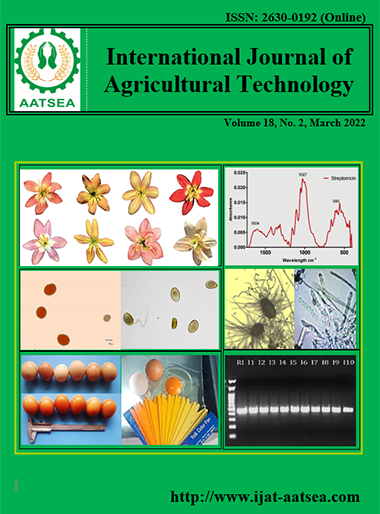Phytochemical screening of indigenous plants utilized by the Agta community in Aurora, Philippines
Main Article Content
Abstract
Plants have long been recognized as a potential source of herbal and medicinal representatives before establishing modern and therapeutic medicine. The Philippines is home to a diverse range of indigenous flora communities, an essential source of ethnobotanical components. This study focused on detecting the phytochemical profile of indigenous plants to verify the folkloric beliefs of the Agta Community of Bazal-Baubo in Aurora, Philippines. Preliminary phytochemical screening revealed the presence of alkaloids, anthraquinone, flavonoids, glycosides, saponins, steroids, tannins, and terpenoids in the plants’ ethanol extract, namely: Manihot esculenta (Euphorbiaceae), Premna odorata (Lamiaceae), Terminalia macrocarpa (Combretaceae), Syzygium polycephaloides (Myrtaceae), and Urena lobata (Malvaceae). The analysis confirmed that five indigenous plants utilized by the Agta community have a potential source of plant bioactive constituents. It is strongly recommended that pharmacological screenings and functionality of plant extract such as antimicrobial, anti-inflammatory, and antioxidant to validate plants’ phytochemistry
Article Details

This work is licensed under a Creative Commons Attribution-NonCommercial-NoDerivatives 4.0 International License.
References
Adekunle, A. A. and Ikumpayi, A. M. (2006). Antifungal Property and Phytochemical Screening of the Crude Extracts of Funtumia elastica and Mallotus oppositifolius. West Indian Medical Journal, 55: 219-223.
Afoakwa, E. O., Asiedu, C., Budu, A. S., Chiwona-Karltun, L. and Nyirendah, D. B. (2012). Chemical composition and cyanogenic potential of traditional and high yielding CMD resistant cassava (Manihot esculenta Crantz) varieties, International Food Research Journal, 19:175-181.
Akinmo-laudn, A. C., Ibukun, E. O., Afor, E., Obuotor, E. M. and Farombi, E. O. (2007). Phytochemical constituents and antioxidant activity of extracts from leaves of Ocimum gratissimum, Scientific Research and Essays, 2:163-166.
Bahekar, S. E. and Kale, R. S. (2015). Antidiarrheal activity of ethanolic extract of Manihot esculenta Crantz leaves in Wistar rats. Journal of Ayurveda and integrative medicine, 6:35-40. https://doi.org/10.4103/0975-9476.146542
Balangcod, T. D. and Balangcod, K. D. (2015). Ethnomedicinal Plants in Bayabas, Sablan, Benguet Province, Luzon, Philippines, Electronic Journal of Biology, 11:63-73.
Balberona, A. N., Angeles, M. G. B., Cachin, E. J. D. J., Cruz, K. G. J., Noveno, J. J. and Santos, R. I. (2018). Ethnomedicinal Plants Utilized by the Ilongot-Eǵongot Community of Bayanihan, Maria Aurora, Aurora, Philippines. International Journal of Agricultural Technology, 14:145-159. Available online. http://www.ijat-aatsea.com ISSN 2630-0192.
Benmehdi, H., Benali, O., Hasnaoui, O. and Salhi, F. (2012). Phytochemical investigation of leaves and fruits extracts of Chamaerops humilis L. J. Mater. Environmental science, 3:320-237.
Dela Cruz, P. and Ramos, A. (2006). Indigenous Health Knowledge Systems in the Philippines: A Literature Survey. Paper presented at the 13th CONSAL Conference, Manila, Philippines.
Doctor, T. R. and Manuel, J. F. (2014). Phytochemical Screening of Selected Indigenous Medicinal Plants of Tublay, Benguet Province, Cordillera Administrative Region, Philippines. International Journal of Scientific and Research Publications, Volume 4, Issue 4, April 2014 1 ISSN 2250-3153.
Gruyal, G. A., Del Rosario, R. and Palmes, N. (2014). Ehno-medicinal plants used by residents in Northern Surigao, del Sur, Philippines. Natural Products Chemistry and Research.
Harborne, J. B. (1998). Textbook of Phytochemical Methods. A Guide to Modern Techniques of Plant Analysis. 5th Edition, Chapman and Hall Ltd, London, 21-72.
Krentz, A. J. and Bailey, C. J. (2005). Oral antidiabetic agents: current role in type 2 diabetes mellitus. Drugs, 65:385-411.
Kokate, C. K. (2005). A Textbook of Practical pharmacognosy, 5th Edition, Vallabh Prakashan, New Delhi, pp.107-111.
Krishnaiah, D., Bono, A. and Sarbatly, R. (2007). Phytochemical antioxidants for health and medicine: A move towards nature. Biotechnology and Molecular Biology Reviews, 1:97-104.
Murphy, D. J., Thomas, B. and Murray, B. G. (2017). Encyclopedia of Applied Plant Sciences (Second Edition). Amsterdam; Boston: Elsevier Academic, pp. 118-124.
Olowa, L. F., Aranico, E. C., Demayo, C. G. and Torres, M. A. (2012). Medicinal plants used by the higaonon tribe of Rogongon, Iligan City, Mindanao, Philippines. Advances in Environmental Biology, 6:1442-1449.
Rievere, C., Dejaegher, B., Heyden, Y. V., Minh, C. V., Pieters, L., Quetin-Leclercq, J. and Van Nguyen, T. H. (2009). Polyphenols isolated from antiradical extracts of Mallotus metcalfianus. Phytochemistry, 70:86-94.
Sofowora, A. (1993). Medicinal Plants and Traditional Medicine in West Africa. Spectrum Books Limited., Ibadan, pp.191-289.
Tantengo, O. A., Condes, M. L., Estadilla, H. H. and Ragragio, E. (2018). Ethnobotanical Survey of Medicinal Plants used by Ayta Communities in Dinalupihan, Bataan, Philippines. Pharmacognosy Journal, Vol 10, Issue 5.
Trease, G. E. and Evans, W. C. (1989). Pharmacognosy 11th Edition; Brailliar Tiridacanb Macmillian Publishers.
Tsumbu, C. N., Angenot, L., Deby-Dupont, G., Franck, T., Mouithys-Mickalad, A., Serteyn, D. and Tits, M. (2011). Antioxidant and Antiradical Activities of Manihot esculenta Cranz (Euphorbiaceae) Leaves and Other Selected Tropical Green Vegetables Investigated on Lipoperoxidation and Phorbol-12-myristate-13-acetate (PMA) Activated Monocytes. Nutrients, 3:818-838. https://doi.org/10.3390/nu 3090818


